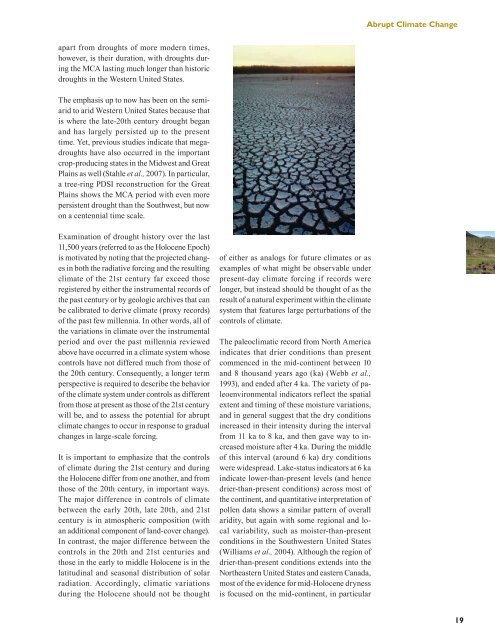Book 2.indb - US Climate Change Science Program
Book 2.indb - US Climate Change Science Program
Book 2.indb - US Climate Change Science Program
- No tags were found...
Create successful ePaper yourself
Turn your PDF publications into a flip-book with our unique Google optimized e-Paper software.
Abrupt <strong>Climate</strong> <strong>Change</strong>apart from droughts of more modern times,however, is their duration, with droughts duringthe MCA lasting much longer than historicdroughts in the Western United States.The emphasis up to now has been on the semiaridto arid Western United States because thatis where the late-20th century drought beganand has largely persisted up to the presenttime. Yet, previous studies indicate that megadroughtshave also occurred in the importantcrop-producing states in the Midwest and GreatPlains as well (Stahle et al., 2007). In particular,a tree-ring PDSI reconstruction for the GreatPlains shows the MCA period with even morepersistent drought than the Southwest, but nowon a centennial time scale.Examination of drought history over the last11,500 years (referred to as the Holocene Epoch)is motivated by noting that the projected changesin both the radiative forcing and the resultingclimate of the 21st century far exceed thoseregistered by either the instrumental records ofthe past century or by geologic archives that canbe calibrated to derive climate (proxy records)of the past few millennia. In other words, all ofthe variations in climate over the instrumentalperiod and over the past millennia reviewedabove have occurred in a climate system whosecontrols have not differed much from those ofthe 20th century. Consequently, a longer termperspective is required to describe the behaviorof the climate system under controls as differentfrom those at present as those of the 21st centurywill be, and to assess the potential for abruptclimate changes to occur in response to gradualchanges in large-scale forcing.It is important to emphasize that the controlsof climate during the 21st century and duringthe Holocene differ from one another, and fromthose of the 20th century, in important ways.The major difference in controls of climatebetween the early 20th, late 20th, and 21stcentury is in atmospheric composition (withan additional component of land-cover change).In contrast, the major difference between thecontrols in the 20th and 21st centuries andthose in the early to middle Holocene is in thelatitudinal and seasonal distribution of solarradiation. Accordingly, climatic variationsduring the Holocene should not be thoughtof either as analogs for future climates or asexamples of what might be observable underpresent-day climate forcing if records werelonger, but instead should be thought of as theresult of a natural experiment within the climatesystem that features large perturbations of thecontrols of climate.The paleoclimatic record from North Americaindicates that drier conditions than presentcommenced in the mid-continent between 10and 8 thousand years ago (ka) (Webb et al.,1993), and ended after 4 ka. The variety of paleoenvironmentalindicators reflect the spatialextent and timing of these moisture variations,and in general suggest that the dry conditionsincreased in their intensity during the intervalfrom 11 ka to 8 ka, and then gave way to increasedmoisture after 4 ka. During the middleof this interval (around 6 ka) dry conditionswere widespread. Lake-status indicators at 6 kaindicate lower-than-present levels (and hencedrier-than-present conditions) across most ofthe continent, and quantitative interpretation ofpollen data shows a similar pattern of overallaridity, but again with some regional and localvariability, such as moister-than-presentconditions in the Southwestern United States(Williams et al., 2004). Although the region ofdrier-than-present conditions extends into theNortheastern United States and eastern Canada,most of the evidence for mid-Holocene drynessis focused on the mid-continent, in particular19






